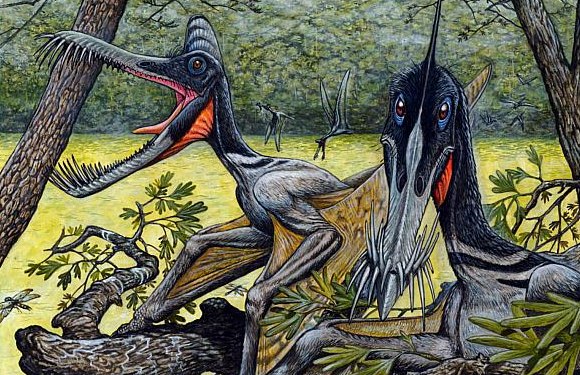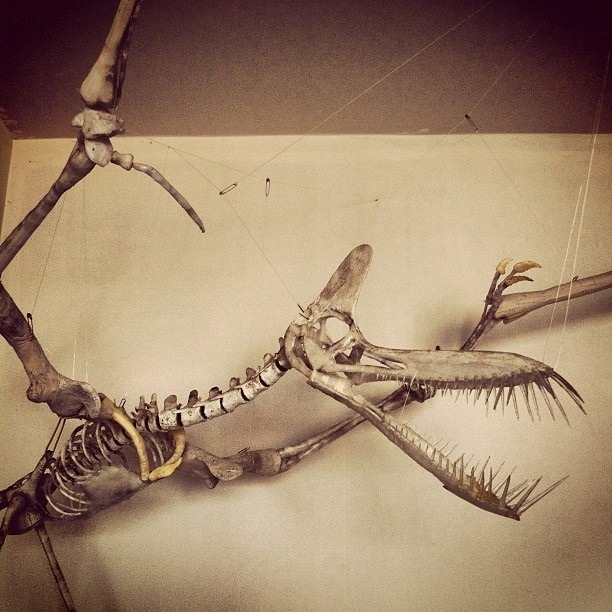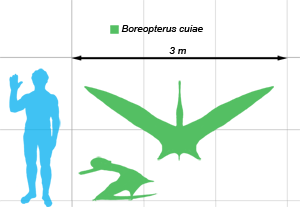[Recent Entries][Archive][Friends][User Info]
Below are the 3 most recent journal entries recorded in the "Сообщество, посвящённое ра" journal:| November 27th, 2014 | |
|---|---|
| 10:11 pm [industrialterro] [Link] |
Zhenyuanopterus Zhenyuanopterus is a genus of pterosaur which is known from Lower Cretaceous (early Aptian) Yixian Formation of Liaoning, China. It has been suggested that Zhenyuanopterus foraged while swimming, trapping prey within its needle-like teeth, a method similar to that of modern Platanista river dolphins, which display a similar dentition. This is a reasonably large pterosaur, with a wingspan of about 4 m (Lü 2010). One more interesting thing to say about these pterosaurs – and this isn’t unique to boreopterids but goes for ornithocheirids as well – look how tiny their feet are! It also seems that some ornithocheiroids lack fibulae, but it remains uncertain how widespread this is (among boreopterids, Boreopterus lacks them but this was assumed to be preservational, while Zhenyuanopterus has them). The enormous wings and very small, weak legs of many ornithocheiroids show pretty convincingly that they were predominantly aerial, that they walked little, and that they made a living by grabbing objects while in flight. What a strong contrast to long-legged, relatively short-winged pterodactyloids like the azhdarchids. It has been often suggested that this animal is actually the adult of its close relative Boreopterus, which is known to be a juvenile.
Tags: Вымершие рептилии, Мел, авеметатарзалии, архозавроморфы, архозавры, бореоптериды, диапсиды, монофенестраты, орнитохейройды, птеранодонтойды, птеродактили, птерозавры |
| May 28th, 2014 | |
| 05:48 pm [industrialterro] [Link] |
Guidraco Guidraco (Chin. gui (鬼) "malicious ghost" + Lat. draco "dragon") is an extinct genus of toothed pterodactyloid pterosaur known from the Early Cretaceous of Liaoning Province, northeast China. Guidraco is known only from the holotype IVPP V17083, an articulated partial skeleton consisting of a nearly complete skull, lower jaws and a series of four, second to fifth, cervical vertebrae. It was collected at Sihedang near Lingyuan City in the Liaoning Province from the Jiufotang Formation, dating to the Aptian stage of the Early Cretaceous, about 120 million years ago. Guidraco was first described and named by Wang Xiaolin, Alexander W.A. Kellner, Jiang Shunxing and Cheng Xin in 2012 and the type species is Guidraco venator. The generic name is derived from Chinese gui (鬼), "malicious ghost", and from Latin draco, "dragon". The specific name means "hunter" in Latin. The holotype skull of Guidraco has a length of thirty-eight centimetres. It is very elongated with a hollow profile but not very pointed as the upper edge and the line of the jaw run nearly parallel over most of their length. The ensuing relative robustness of the snout is reinforced by a short main skull opening, a fenestra nasoantorbitalis with just a quarter of skull length, and a lower jaw equalling the rostrum in depth. The snout lacks a crest. Above the eye sockets however, the line of the top of the snout curves steeply upwards, resulting in a very large crest on the frontals, as high as the posterior part of the skull is deep, ending in a rounded top. Due to the angling of the skull roof the crest slightly points forwards and its base extends to the back of the roof; however, the parietal is not part of it. In front of the crest large impressions of soft tissue are visible but these are plant remains. Further diagnostic features of the skull include an infratemporal fenestra with a narrow lower end, and a jugal of which the front branch extends no further than the front edge of the fenestra nasoantorbitalis. The teeth of Guidraco are very distinctive. Of the twenty-three teeth of the upper jaw the first is long and very narrow, pointing nearly horizontally forward. The next three teeth are enormous in size, very long, robust, pointed and slightly recurved. They gradually point more downwards. These are followed by a series of three medium-length downward-pointing straight teeth, of which the middle one, the sixth, is the shortest. The remaining thirteen teeth constitute a long row of small elements gradually diminishing in size. This arrangement is mirrored by the eighteen teeth of the lower jaw. Here however, a forward pointing tooth is lacking. The first four teeth are of great size, even longer than their counterparts of the upper jaw. Next is a series of three straight teeth of medium height, followed by a row of eleven increasingly smaller elements for a grand total in the head of eighty-two teeth. With the fossil, the beak is closed and due to their extreme length the front teeth extend far beyond the upper and lower edges of the head, the protruding parts being up to twice as long as the depth of the snout or lower jaw. The teeth can also be divided into two types according to their built: the first nine teeth of the upper jaw and eight teeth of the lower jaw have vertical ridges on the back of their enamel; the back teeth have a uniformly smooth enamel and thickened crown bases, giving them a more triangular outline. Though not having the form of a true rosette because the jaw ends were not expanded, the intermeshing front teeth functioned as a "prey grab" to catch slippery animals; the describers therefore consider Guidraco to have been a fish-eater. The neck vertebrae are moderately elongated, keeled and possess large pneumatic openings on their sides, the access by which the air sac of the neck could enter their hollow interiors. The axis bears a spiked spine. Guidraco was by the describers assigned to the Pteranodontoidea sensu Kellner. A phylogenetic analysis found it to be the sister taxon of the Brazilian Ludodactylus, the two species together forming a clade that was closely related to the Istiodactylidae and the Anhangueridae. The fact that a Chinese form is closely related to a South-American species would indicate a large faunal interchange between continents in this period. Китайская академия наук на днях опубликовала документы, согласно которым на северо-востоке страны ученые обнаружили останки птерозавра редкого типа, имевшего длинные зубы устрашающего вида. Согласно опубликованным фотографиям, доисторическая летающая рептилия имела мощные челюсти и крупные резцовые зубы. Палеонтологи говорят, что найденный вид является довольно близким биологическим родственником вида Ludodactylus, останки которого в прошлом были обнаружены учеными на территории современной Бразилии. Согласно данным исследователей, рептилия обитала на нашей планете в ранний меловой период - как раз в расцвет эпохи динозавров. Останки ящера были найдены на территории современной китайской провинции Ляонин, где ранее уже находили останки летающих ящеров. Ископаемые останки и реплики (1, 2, 3, 4): Tags: Вымершие рептилии, Мел, авеметатарзалии, архозавроморфы, архозавры, бореоптериды, диапсиды, монофенестраты, орнитохейройды, птеранодонтойды, птеродактили, птерозавры |
| April 30th, 2014 | |
| 03:05 pm [industrialterro] [Link] |
Boreopterus Boreopterus is a genus of pterodactyloid pterosaur from the Barremian-Aptian-age Lower Cretaceous Yixian Formation of Dalian, Liaoning, China. The genus was in 2005 named by Lü Jinchang and Ji Qiang. The type species is Boreopterus cuiae. The genus name is derived from Greek boreios, "northern" and pteron, "wing". The specific epithet was chosen to dedicate Cui Xu. The genus is based on holotype JZMP-04-07-3, a nearly complete but crushed skeleton and skull. The skull is 235 millimeters long (9.25 inches), low and elongated with a rounded tip. Its wingspan is estimated to have been around 1.45 meters (4.76 feet). Its teeth, especially the anterior nine pairs, are quite large, forming a mesh of sharp teeth at the front of the mouth; the third and fourth teeth from the front are the largest. There are at least 27 teeth in each side of both the upper and lower jaws, which is a large amount. Lü and Ji initially placed Boreopterus in the Ornithocheiridae when they described it in 2006, a classification which was supported later that year by David Unwin. However, Lü in 2006 published a cladistic analysis showing Boreopterus to be the sister taxon of Feilongus (together forming the new family, Boreopteridae) in a position more basal than Haopterus. In 2013, a more comprehensive study of pterosaur relationships supported the close relationship of Boreopterus and Feilongus, as well as their relatively basal status among pterodactyloids. Andres & Myers (2013) found the "boreopterids" as the sister group of Cycnorhamphus within the archaeopterodactyloid group Gallodactylidae. Pterosaurs like Boreopterus are interpreted by Unwin as soaring animals, like today's albatrosses and frigatebirds. However, it has also been suggested that boreopterids foraged while swimming, trapping small prey with their needle-like teeth, a method similar to that of modern Platanista dolphins. It has been suggested that the closely related Zhenyuanopterus was merely the adult form of this animal. Boreopteridae (meaning "northern wings") is a group of ornithocheiroid pterosaurs from the Aptian-age Lower Cretaceous Yixian Formation of Liaoning, China. In 2006, Lu and colleagues named the clade Boreopteridae for the clade containing the common ancestor of Boreopterus and Feilongus and all its descendants, which the authors reclassified as close relatives of the ornithocherids. (Feilongus had originally been considered a gallodactylid). Many possible boreopterids were subsequently described, one possible example being Aetodactylus, which has been claimed to be similar to Boreopterus. Originally considered close relatives of the ornithocheirids, many of these supposed boreopterids have been found to belong to other groups of the pterodactyloid lineage. Boreopterus and Feilongus were found by Andres and colleagues in 2013 to be closely related to Cycnorhamphus, making them members of the Gallodactylidae as had been originally thought when Feilongus was discovered. A subsequent analysis including the other supposed boreopterids found that Boreopterus itself, and therefore the name Boreopteridae, was indeed a member of the ornithocheiroid clade, but that Feilongus was in fact a ctenochasmatoid closely related to Gnathosaurus. According to Andres and colleagues (2014), the true boreopterid clade is limited to Boreopterus, Guidraco, and Zhenyuanopterus. The known taxa come from the Yixian Formation of Liaoning, which represented a lake system, suggesting that these animals occurred in freshwater habitats. They are thought to have foraged while swimming, trapping prey with their needle-like teeth; this method of fishing was probably analogous to that of Platanista dolphins, which share a similar dentition. Many possible ornithocheirid remains might actually belong to boreopterids, a possible example being Aetodactylus, which has been claimed to be similar to Boreopterus Размеры тела в сравнении с человеком: Tags: Вымершие рептилии, Мел, авеметатарзалии, архозавроморфы, архозавры, бореоптериды, диапсиды, монофенестраты, орнитохейройды, птеранодонтойды, птеродактили, птерозавры |



















